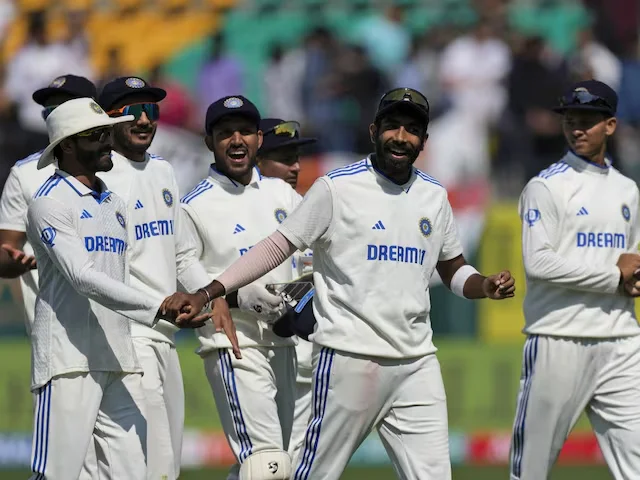
Ben Stokes: Leadership in the Spotlight
Ben Stokes, notwithstanding amassing 199 tallies and securing one scalp, steered England to a robust exhibition across two Tests and a duo of days of arduous combat against Bharat. Albeit his avant-garde field configurations, England grappled with batting disintegrations, akin to Bharat’s prowess and sagacity. Stokes was accorded a B-minus for his endeavors.
Zak Crawley: A Rising Star
Zak Crawley emerged as the potential leading batsman for England, amassing 407 runs at an average of 41, the highest by an English player in the series. His journey included four promising half-centuries, though he might regret not converting any into larger scores. Crawley demonstrated a commendable adaptability to the varying demands of the game, balancing aggressive play with strategic patience. His consistency was a silver lining, especially noted in his ability to contribute significantly before departing, a stark contrast to the team’s overall batting fragility. For his standout performance and reliability, Crawley receives a Grade B.
Ben Duckett and Ollie Pope Performance Overview
Ben Duckett’s Dynamic Display: Garnering 343 runs with an average of 34 and securing four catches, Ben Duckett, England’s dynamo, left an indelible mark with a remarkable 153-run innings at Rajkot, catapulting England back into contention in the series. Despite this high, his performance in the subsequent five innings saw a dip, with 27 being his highest score. His aggressive batting style, filled with bold cuts, slashes, and sweeps, remains unaltered by criticism or match conditions. While it’s unlikely he’ll temper his approach, it could prompt adjustments from teammates, especially in overseas matches, to maintain wicket stability. Grade: C+
Ollie Pope’s Inconsistent Journey: With 315 runs at an average of 32 and six catches to his name, England’s vice-captain Ollie Pope showcased a mix of brilliance and inconsistency. His monumental 196 in the first Test transformed a daunting deficit into a victorious lead, marking a career highlight. However, his performance in the remaining innings lacked the same impact, failing to cross 40 in nine attempts. Despite this, his exceptional innings in Hyderabad hinted at his potential, suggesting a need for a more consistent strategy that befits his experience and role. Grade: C+
Joe Root’s Performance Review
Joe Root demonstrated commendable versatility with a total of 320 runs at an average of 36, along with securing eight wickets at an average of 51 and taking 10 catches. In the latter part of the series, Root’s exceptional scores of 122 and 84 in the final two Tests were pivotal in averting a complete embarrassment for the team. His adaptability was particularly evident when he was relieved from his primary role as a spinner, which seemingly allowed him to revert to his renowned proficiency as a batsman known for his expertise in subcontinental conditions. However, this shift in roles possibly contributed to a couple of critical missed catches at slip, potentially due to a lapse in concentration from the overwhelming demands placed on him. Despite these challenges, Root’s overall contribution was substantial, earning him a Grade B-.
Jonny Bairstow’s Assessment
Jonny Bairstow accumulated 238 runs at an average of 24 and was responsible for three catches. Despite having multiple opportunities to make a significant impact, Bairstow was unable to convert his starts into substantial innings, often getting out within the 25 to 39 run range in an attempt to find his rhythm. The current selection philosophy may still favor him for future matches, possibly including the upcoming series at Lord’s against the West Indies, but his performance in this series was underwhelming, resulting in a Grade D.
Ben Foakes’ Evaluation
Ben Foakes delivered a solid performance, particularly behind the stumps, with 205 runs at an average of 21, 12 catches, and four stumpings. His wicket-keeping, especially against spin bowling, was exemplary, showcasing traditional skills of anticipation and agility. Foakes’ moments of brilliance provided spectators with instances of pure enjoyment, though his role as a counter-attacker at the number 7 position was limited by the team’s weaker late order. His contributions, primarily with the gloves, were commendable, earning him a Grade B.
Tom Hartley’s Season Summary
Tom Hartley made a significant impact this season with his all-round performance, scoring 185 runs at an average of 19 and taking 22 wickets at an average of 36, alongside making two catches. Despite facing early challenges from aggressive batters, Hartley maintained his composure, backed by his captain’s faith. His strategic bowling, characterized by an attacking line and leveraging his height for turn and bounce, earned him wickets and respect from renowned spin players. Over five matches, he bowled 250 overs, showcasing remarkable concentration and resilience. Hartley’s batting also displayed a daring edge, earning him a B+ grade.
James Anderson’s Season Review
Veteran bowler James Anderson, known for his skill and experience, contributed 13 runs at an average of 3 and secured 10 wickets at an average of 34, with two catches to his name. Anderson adapted to unfamiliar conditions with his trademark determination, delivering 110 overs across four Tests. His strategic use by the captain and the respect from opponents highlighted by 20 maidens, attest to his enduring prowess in the cricket world. Anderson’s performance this season is rated at a B.
Shoaib Bashir’s Performance Overview
Shoaib Bashir, despite joining the team late, quickly made his mark by scoring 33 runs at an average of 11 and taking 17 wickets at an average of 33, along with one catch. His aggressive and expectant bowling style resulted in significant breakthroughs, showcasing his potential with two five-wicket hauls. Bashir’s ability to deliver overspun, dipping balls poses a particular threat to left-handed batters. As he prepares for more county cricket, his performance earns him a B+ grade.
Rehan Ahmed’s Season Performance
Young leg-spinner Rehan Ahmed displayed boldness and potential with 76 runs at an average of 13, 11 wickets at an average of 44, and three catches. Despite his talent, Ahmed’s need for better control was evident, with infrequent deliveries overshadowing his exceptional ones. His captain’s hesitancy to use him regularly suggests areas for growth. Ahmed’s future in red-ball cricket remains uncertain, though his prospects in shorter formats are promising. His season is graded at a C.
Limited Impact
Mark Wood’s campaign was marked by a brief moment of brilliance in Rajkot, where he dismissed India’s emerging stars, sparking a glimmer of hope for England. This instance stood out as his sole wicket-taking appearance, with his usually formidable pace becoming less effective due to the lack of conducive conditions for swing. His overall contribution was moderate, earning him a Grade C-.
Promising with the Bat, Struggled with the Ball
Ollie Robinson showed promise with the bat, demonstrating both skill and strategic acumen. However, his return to the bowling crease after a significant hiatus resembled that of a debutant, lacking impact and failing to claim any wickets. Given the circumstances, a harsh judgment might be unfair, yet inevitable, resulting in a Grade C
Hindered by Injury
Jack Leach’s participation was once again limited due to injury, affecting his ability to contribute significantly as England’s preferred spinner. He observed the successful strategies employed by younger teammates, particularly their aggressive bowling and managed economy rates, which will be valuable insights for the future. His limited playtime led to a Grade C.
Indian Cricket Team Performance Highlights
Rohit Sharma’s Contribution
Rohit Sharma, the Indian captain, accumulated 400 runs with an average of 44, including two centuries and a half-century in the latter part of the series, significantly impacting England’s defeat. His field captaincy may appear less assertive compared to his predecessor, but his leadership was pivotal in rallying the team after an initial series loss, focusing on overcoming the absence of key players. His performance earned him an A- grade.
Yashasvi Jaiswal: Rising Star
Yashasvi Jaiswal emerged as a beacon of talent, amassing 712 runs at an astonishing average of 89. His remarkable balance, agile footwork, and timely aggression have led many to view him as a potential global cricket icon, reminiscent of Brian Lara’s legacy. With an A+ grade, his future in international cricket is highly anticipated.
Shubman Gill’s Recovery
Shubman Gill faced early challenges in the series but silenced critics with a pivotal century that helped India recover in a critical match. His total of 452 runs at an average of 57, coupled with six catches, reflects his resilience and ability to bounce back, earning him an A- grade.
Sarfaraz Khan Makes His Mark
Sarfaraz Khan, erstwhile a domiciliary cognomen in Pakistani cricket, capitalized on his opportunity to represent his nation by amassing 200 runs at a quotient of 50 across three Tests. He merited a B+ for invigorating the cadre with his zestful presence on the field and jubilant acclamations post-catch.
Devdutt Padikkal’s Steady Debut
Devdutt Padikkal, in his role in the fifth Test, proved his mettle against a weary opposition with 65 runs at an average of 65 and two catches. His performance positions him amidst a burgeoning pool of batting talent, earning a B+ grade for his contributions.
Dhruv Jurel’s Impressive Rise: A Stellar Performance
Dhruv Jurel’s meteoric ascent in the cricket world is nothing short of remarkable. With a hefty score of 190 runs at an average of 63, complemented by five catches and two stumpings, Jurel has made an indelible mark in just two short years. Transitioning from his first-class debut to securing a spot in the Test XI, his prowess shines equally on both sides of the wicket. In a time when wicketkeepers are often chosen for their batting skills and taught the finer points of keeping on the fly, Jurel’s natural talent behind the stumps is a refreshing change. Even as Rishabh Pant approaches full recovery, he might find himself in a batting-centric role, given Jurel’s continued excellence. Jurel earns a well-deserved Grade A for his performance.
KS Bharat’s Steady Effort
KS Bharat, with a tally of 92 runs at an average of 23 and six catches, has shown commendable effort. Despite not making any significant errors in his two matches, the unforgiving nature of top-tier sports meant he had to make way for more exceptional talent. At 30, Bharat faces a challenging journey back to prominence, receiving a Grade C+ for his contributions.
KL Rahul’s Elegant Brief Stint
KL Rahul maintained his elegant form, scoring 108 runs at an average of 54 in the only Test he played before an injury sidelined him. His performance, albeit brief, was noteworthy, earning him a Grade B+.
Shreyas Iyer’s Missed Opportunities
Shreyas Iyer managed 104 runs at an average of 26 and took one catch but struggled to convert promising starts into significant scores. His last century, now 14 Tests ago, seems a distant memory. With India potentially looking towards younger talent in the post-Kohli and post-Rohit era, Iyer’s future remains uncertain, reflected in his Grade C-.
Rajat Patidar’s Overwhelming Challenge
Rajat Patidar, substituting for KL Rahul subsequent to the inaugural Test, encountered arduous endeavors amassing 63 tallies at a mean of 11 alongside quartet grasps. Engulfed by the enormity of the ordeal, he was omitted by the quintet Test. Analogous to Bharat, Patidar’s trajectory henceforth remains nebulous, bequeathing him a Grade D for his endeavor.
Key Indian Cricketers
Ravindra Jadeja’s Impressive All-Round Contribution
Ravindra Jadeja continues to be a vital cog in the Indian cricket machinery, often going unnoticed due to the consistent high standards he sets. His remarkable century at a critical juncture in Rajkot, lifting India from a precarious position, and his pivotal 5-wicket haul that quashed England’s comeback hopes, are testaments to his value. Although his run contribution waned thereafter, his knack for taking crucial wickets didn’t, earning him a well-deserved B+ grade.
Ravichandran Ashwin’s Tactical Mastery
Despite a seemingly distracted start, possibly due to personal commitments, Ravichandran Ashwin bounced back with the strategic depth that has characterized his long career. His 15-wicket haul post-return was instrumental in India’s dominant series win, reflecting his undiminished skill and earning him a solid B grade.
Kuldeep Yadav’s Emergence as a Key Spinner
When Jadeja was sidelined due to an ailment, Kuldeep Yadav filled the breach and proved to be exceedingly sufficient. His extraordinary mean and impact frequency, amalgamated with his unique southpaw carpus twirl, confounded the English willow wielders. He merited an estimable A- for his unswerving execution both in bowling and wielding the willow.
Axar Patel’s Mixed Fortunes
Axar Patel, known for his distinctive bowling, found the evenly poised pitches less favorable to his style this series. While his contributions with the bat were valuable, they were not enough to secure a higher place in the batting order, culminating in a C+ grade.
Mohammed Siraj’s Aggressive Bowling
Mohammed Siraj’s spirited performance, particularly his impactful four-wicket haul in Rajkot, underscored his aggressive bowling style. However, limited bowling opportunities throughout the series suggest that the team had other preferred bowling options, leading to a C+ grade for Siraj.
Jasprit Bumrah’s Impressive Performance
Statistical Summary: Achieved 58 runs with an average of 12, secured 19 wickets with an impressive average of 17, and took four catches.
In-Depth Analysis: Jasprit Bumrah stood out as the unparalleled leader of India’s bowling lineup, with his 19 wickets at an average of 17 marking a remarkable deviation from the norm among fast bowlers. His exceptional performance, including nine wickets in Vizag, was pivotal in India’s comeback in the series, earning him the Player of the Match award over the double-centurion Jaiswal. Bumrah’s skill in extracting bounce and movement from unyielding pitches, thanks to his unique wrist action and exceptional control, places him among India’s elite bowlers, a stature not seen since the likes of Dale Steyn. Regarded as India’s finest opening bowler since Kapil Dev, Bumrah’s trajectory suggests he might even eclipse the legendary cricketer’s legacy. Assessment: Grade A
Akash Deep’s Debut Performance
Statistical Overview: Amassed nine tallies at a mean of 9, secured three dismissals at a median of 28, and executed a solitary snag.
Review: Akash Deep’s debut in Test cricket was like a fairy tale, as he dismissed England’s top three batsmen in Ranchi. Despite not bowling in the second innings and being replaced by Bumrah for the final Test, his initial performance was commendable. Assessment: Grade B-
Mukesh Kumar’s First Appearance
Performance Snapshot: Did not score, took one wicket at an average of 70.
Evaluation: Mukesh Kumar’s debut in Vizag was unremarkable, with his performance possibly perceived as lackluster by the team’s captain, who limited him to only 12 expensive overs. He was not selected for further matches. Assessment: Grade D






